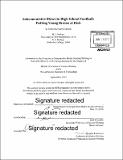Subconcussive blows in high school football : putting young brains at risk
Author(s)
Caruso, Catherine Curro
DownloadFull printable version (1.736Mb)
Other Contributors
Massachusetts Institute of Technology. Graduate Program in Science Writing.
Advisor
Seth Mnookin.
Terms of use
Metadata
Show full item recordAbstract
In 2009, Larry Leverenz, Eric Nauman, and Thomas Talavage at Purdue University formed the Purdue Neurotrauma Group (PNG), and set out to study concussions in high school football. They set up a study that combined helmet sensors with fMRI brain scans and cognitive testing, hoping to figure out what happens when a player gets a concussion on the field. Instead, they uncovered something shocking and wholly unexpected. Players' brains were significantly changing even in the absence of concussions, due to an accumulation of smaller impacts called subconcussive blows. Years of subsequent research have only confirmed their initial results-season after season, they found that about half of the players in their study that didn't sustain concussions exhibited significant brain changes over the course of a season. They don't yet know exactly how these brain changes relate to short or long-term cognitive damage, but when their findings are scaled across the landscape of high school football, the implications are enormous-brain changes may be occurring in some half a million teenaged athletes. However, even as public awareness of concussions and chronic traumatic encephalopathy (CTE) reaches new heights, subconcussive blows continue to fly under the radar. For the past seven years, the PNG has run their research on a shoestring budget, and now, at the end of their funding, they are running out of time and options. Meanwhile, in a few short months, 1.1 million high school football players will suit up for the start of football season.
Description
Thesis: S.M. in Science Writing, Massachusetts Institute of Technology, Department of Humanities, Graduate Program in Science Writing, 2016. Cataloged from PDF version of thesis. Includes bibliographical references (pages 19-23).
Date issued
2016Department
Massachusetts Institute of Technology. Graduate Program in Science Writing; MIT Program in Writing & Humanistic StudiesPublisher
Massachusetts Institute of Technology
Keywords
Graduate Program in Science Writing.
